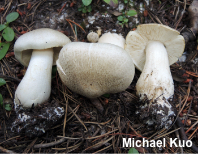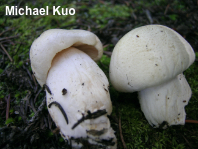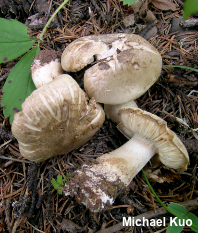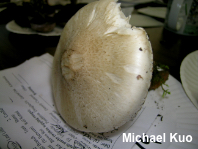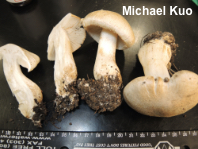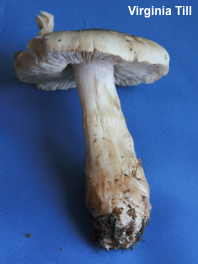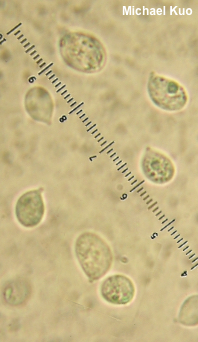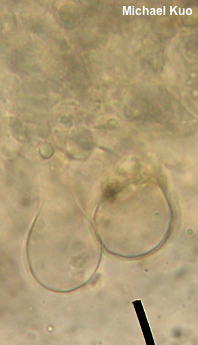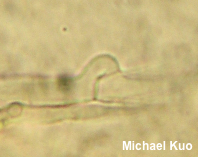| Major Groups > Gilled Mushrooms > Pale-Spored > Tricholoma > Tricholoma smithii |

|
Tricholoma smithii [ Basidiomycota > Agaricales > Tricholomataceae > Tricholoma . . . ] by Michael Kuo Recently described by North American Tricholoma expert Clark Ovrebo, this conifer-associated species is a denizen of western mountains—from Colorado and New Mexico and, possibly, elsewhere. Tricholoma smithii has a whitish to pale brown cap overlaid with radiating brown fibrils and scales. The gills usually age brownish, and the odor of the sliced flesh is usually mealy. Under the microscope, the species features occasional clamp connections and fairly large spores. In the Sierra Nevada, at least two similar mushrooms are recorded by Shanks (1994): Tricholoma pardinum, with cheilocystidia and dark brown scales; and Tricholoma venenatum, without cheilocystidia, and with paler brown scales. The latter is probably not actually Tricholoma venenatum (a hardwood-associated species from midwestern and eastern North America), but might be Tricholoma smithii, despite the lack of cheilocystidia. Description: Ecology: Mycorrhizal with Engelmann spruce, subalpine fir, and other western conifers; growing scattered or gregariously; summer and fall; documented from Colorado and New Mexico, but perhaps present throughout the western mountains. The illustrated and described collections are from Colorado. Cap: 2.5–6.5 cm across; convex to slightly conic, becoming broadly convex or broadly bell-shaped; dry; white to whitish or, occasionally, pale brown underneath small, light brown to brown, radially arranged scales and fibrils. Gills: Attached to the stem by a notch; close; short-gills frequent; whitish, aging brownish. Stem: 2–8 cm long; 1.5–3 cm thick; equal or a little club-shaped; with very fine brownish fibrils over a white ground; dry; discoloring brownish to brown with age or on handling; basal mycelium white. Flesh: White; unchanging when sliced. Odor and Taste: Mealy, or sometimes not distinctive. Chemical Reactions: KOH on cap surface negative to faintly orangish. Spore Print: White. Microscopic Features: Spores 7–10 x 5–7 µm; ellipsoid to sublacrymoid, with a small apiculus; smooth; hyaline in KOH; inamyloid. Lamellar trama parallel. Basidia 4-sterigmate. Cheilocystidia 35–50 x 12–20 µm; sphaeropedunculate or widely cylindric; smooth; thin-walled, or with walls up to 0.5 µm thick; hyaline in KOH. Pleurocystidia absent or, when present, scattered and similar to cheilocystidia. Pileipellis a cutis; elements 3–8 µm wide, smooth, hyaline to yellowish in KOH; occasionally clamped. REFERENCES: Ovrebo & K. W. Hughes, 2018. (Ovrebo & Hughes, 2018.) Herb. Kuo 08110705 (paratype), 08191101, 08191102, 08101803. DBG RMNP 2008-274 2012-5027-33. This site contains no information about the edibility or toxicity of mushrooms. |
© MushroomExpert.Com |
|
Cite this page as: Kuo, M. (2019, October). Tricholoma smithii. Retrieved from the MushroomExpert.Com Web site: http://www.mushroomexpert.com/tricholoma_smithii.html |
